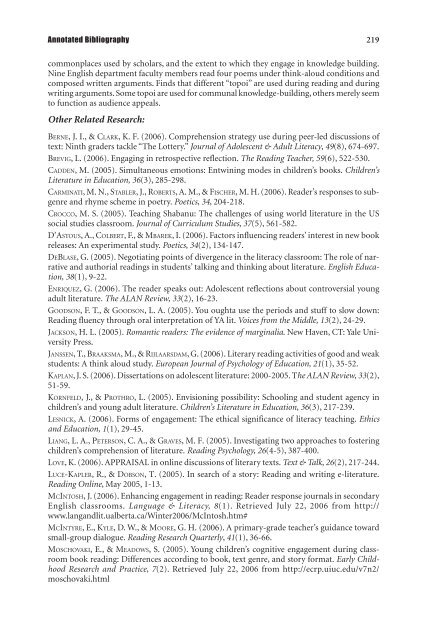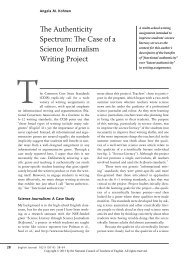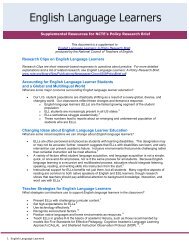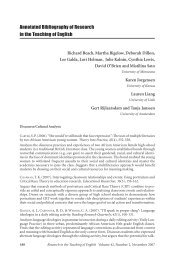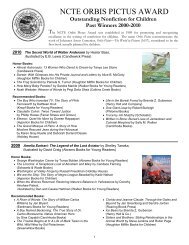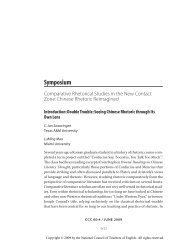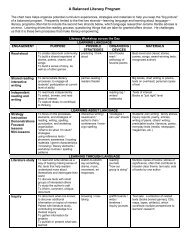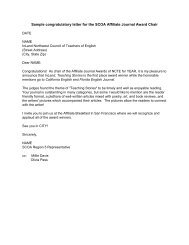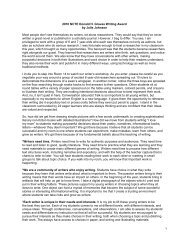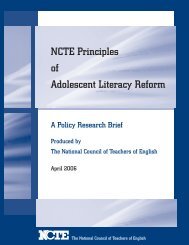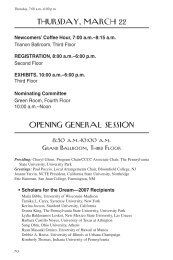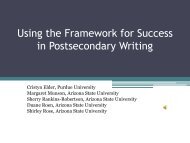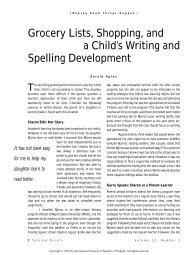Annotated Bibliography of Research in the Teaching of English
Annotated Bibliography of Research in the Teaching of English
Annotated Bibliography of Research in the Teaching of English
- No tags were found...
Create successful ePaper yourself
Turn your PDF publications into a flip-book with our unique Google optimized e-Paper software.
<strong>Annotated</strong> <strong>Bibliography</strong> 219commonplaces used by scholars, and <strong>the</strong> extent to which <strong>the</strong>y engage <strong>in</strong> knowledge build<strong>in</strong>g.N<strong>in</strong>e <strong>English</strong> department faculty members read four poems under th<strong>in</strong>k-aloud conditions andcomposed written arguments. F<strong>in</strong>ds that different “topoi” are used dur<strong>in</strong>g read<strong>in</strong>g and dur<strong>in</strong>gwrit<strong>in</strong>g arguments. Some topoi are used for communal knowledge-build<strong>in</strong>g, o<strong>the</strong>rs merely seemto function as audience appeals.O<strong>the</strong>r Related <strong>Research</strong>:BERNE, J. I., & CLARK, K. F. (2006). Comprehension strategy use dur<strong>in</strong>g peer-led discussions <strong>of</strong>text: N<strong>in</strong>th graders tackle “The Lottery.” Journal <strong>of</strong> Adolescent & Adult Literacy, 49(8), 674-697.BREVIG, L. (2006). Engag<strong>in</strong>g <strong>in</strong> retrospective reflection. The Read<strong>in</strong>g Teacher, 59(6), 522-530.CADDEN, M. (2005). Simultaneous emotions: Entw<strong>in</strong><strong>in</strong>g modes <strong>in</strong> children’s books. Children’sLiterature <strong>in</strong> Education, 36(3), 285-298.CARMINATI, M. N., STABLER, J., ROBERTS, A. M., & FISCHER, M. H. (2006). Reader’s responses to subgenreand rhyme scheme <strong>in</strong> poetry. Poetics, 34, 204-218.CROCCO, M. S. (2005). Teach<strong>in</strong>g Shabanu: The challenges <strong>of</strong> us<strong>in</strong>g world literature <strong>in</strong> <strong>the</strong> USsocial studies classroom. Journal <strong>of</strong> Curriculum Studies, 37(5), 561-582.D’ASTOUS, A., COLBERT, F., & MBAREK, I. (2006). Factors <strong>in</strong>fluenc<strong>in</strong>g readers’ <strong>in</strong>terest <strong>in</strong> new bookreleases: An experimental study. Poetics, 34(2), 134-147.DEBLASE, G. (2005). Negotiat<strong>in</strong>g po<strong>in</strong>ts <strong>of</strong> divergence <strong>in</strong> <strong>the</strong> literacy classroom: The role <strong>of</strong> narrativeand authorial read<strong>in</strong>gs <strong>in</strong> students’ talk<strong>in</strong>g and th<strong>in</strong>k<strong>in</strong>g about literature. <strong>English</strong> Education,38(1), 9-22.ENRIQUEZ, G. (2006). The reader speaks out: Adolescent reflections about controversial youngadult literature. The ALAN Review, 33(2), 16-23.GOODSON, F. T., & GOODSON, L. A. (2005). You oughta use <strong>the</strong> periods and stuff to slow down:Read<strong>in</strong>g fluency through oral <strong>in</strong>terpretation <strong>of</strong> YA lit. Voices from <strong>the</strong> Middle, 13(2), 24-29.JACKSON, H. L. (2005). Romantic readers: The evidence <strong>of</strong> marg<strong>in</strong>alia. New Haven, CT: Yale UniversityPress.JANSSEN, T., BRAAKSMA, M., & RIJLAARSDAM, G. (2006). Literary read<strong>in</strong>g activities <strong>of</strong> good and weakstudents: A th<strong>in</strong>k aloud study. European Journal <strong>of</strong> Psychology <strong>of</strong> Education, 21(1), 35-52.KAPLAN, J. S. (2006). Dissertations on adolescent literature: 2000-2005. The ALAN Review, 33(2),51-59.KORNFELD, J., & PROTHRO, L. (2005). Envision<strong>in</strong>g possibility: School<strong>in</strong>g and student agency <strong>in</strong>children’s and young adult literature. Children’s Literature <strong>in</strong> Education, 36(3), 217-239.LESNICK, A. (2006). Forms <strong>of</strong> engagement: The ethical significance <strong>of</strong> literacy teach<strong>in</strong>g. Ethicsand Education, 1(1), 29-45.LIANG, L. A., PETERSON, C. A., & GRAVES, M. F. (2005). Investigat<strong>in</strong>g two approaches to foster<strong>in</strong>gchildren’s comprehension <strong>of</strong> literature. Read<strong>in</strong>g Psychology, 26(4-5), 387-400.LOVE, K. (2006). APPRAISAL <strong>in</strong> onl<strong>in</strong>e discussions <strong>of</strong> literary texts. Text & Talk, 26(2), 217-244.LUCE-KAPLER, R., & DOBSON, T. (2005). In search <strong>of</strong> a story: Read<strong>in</strong>g and writ<strong>in</strong>g e-literature.Read<strong>in</strong>g Onl<strong>in</strong>e, May 2005, 1-13.MCINTOSH, J. (2006). Enhanc<strong>in</strong>g engagement <strong>in</strong> read<strong>in</strong>g: Reader response journals <strong>in</strong> secondary<strong>English</strong> classrooms. Language & Literacy, 8(1). Retrieved July 22, 2006 from http://www.langandlit.ualberta.ca/W<strong>in</strong>ter2006/McIntosh.htm#MCINTYRE, E., KYLE, D. W., & MOORE, G. H. (2006). A primary-grade teacher’s guidance towardsmall-group dialogue. Read<strong>in</strong>g <strong>Research</strong> Quarterly, 41(1), 36-66.MOSCHOVAKI, E., & MEADOWS, S. (2005). Young children’s cognitive engagement dur<strong>in</strong>g classroombook read<strong>in</strong>g: Differences accord<strong>in</strong>g to book, text genre, and story format. Early Childhood<strong>Research</strong> and Practice, 7(2). Retrieved July 22, 2006 from http://ecrp.uiuc.edu/v7n2/moschovaki.html


